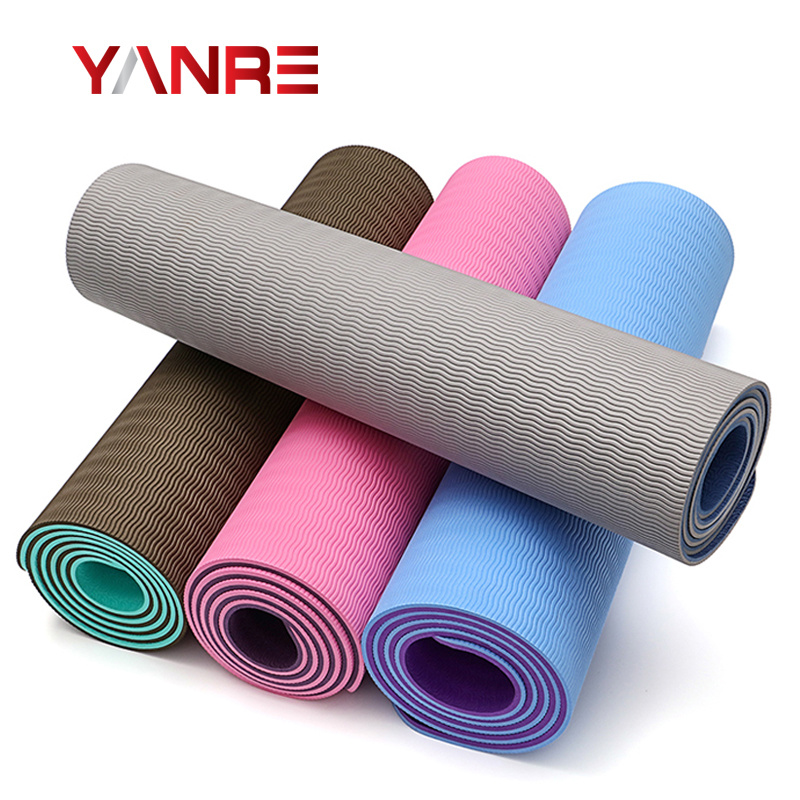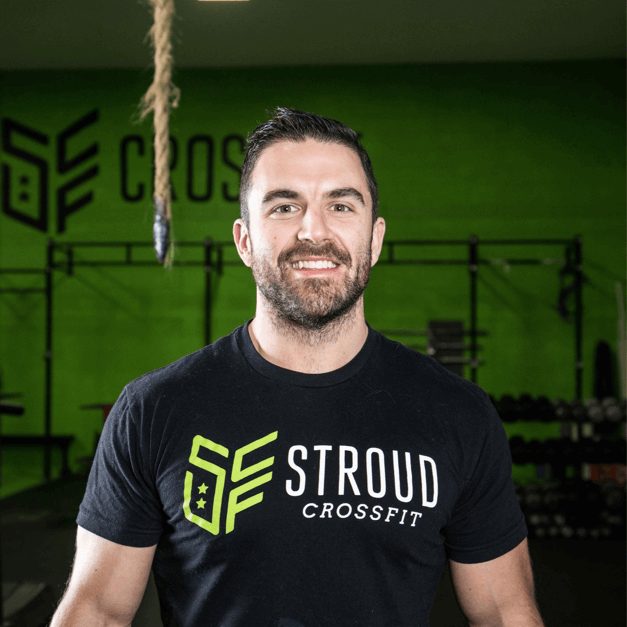From a single material choice for construction & a couple of color choices to the variety available today, yoga mats have come a long way.
All this variety can be overwhelming when you want to choose yoga mats for your commercial gym or fitness business.
This article is a complete guide about commercial yoga mats. It has answers to questions, like:
- What should you look for when buying yoga mats?
- What are the average dimensions of an ideal yoga mat?
- What are things to avoid when getting yoga mats in bulk?
With over a decade of experience in the fitness equipment industry in China, we are in a unique position to guide you in your search for the best wholesale yoga mats.
Our insights, practical advice, & experience are an asset to all gym owners for buying wholesale yoga mats.
So, let’s begin,
(Note: Yoga mats have various names, such as exercise mats, gym mats, sticky mats, fitness mats, workout mats, sports mats, aerobic mats, etc. For the sake of clarity, we will refer to them as yoga mats for the duration of this article)
Table of Contents
Quick Comparison Table
Yoga mats are not as simple as they look. There are many materials that are part of a yoga mat’s construction.
We begin this article with a concise & informative comparison chart to give you a quick idea about various material choices.
It will be a reference to all the details given below about commercial yoga mats.

Types of Commercial Yoga Mats
In the past, manufacturers used PVC for making yoga mats. There is no shortage of materials these days, though.
Nine different material choices are available for yoga mat construction.
The construction of a commercial yoga mat affects its texture, padding, stability, & comfort level.
Yoga mats have different types based on their construction. Such as:
Synthetic Yoga Mats
PVC Material Yoga Mats
PVC or Vinyl is a widely available synthetic material. It is short for Polyvinyl Chloride.
PVC yoga mats are the cheapest ones available in the wholesale market. It is a highly durable material that can last more than a decade with ease.
The demand for PVC mats is due to their easy availability & low cost, despite not being biodegradable & known to release substances toxic to human health.
It is one of the reasons many buyers avoid placing orders for PVC yoga mats.
Pro of PVC Yoga Mats
- Stable & firm grip
- Low-maintenance
- Water-resistant
- Long-lasting
- Cost-effective
- Shock-absorbing
Cons of PVC Yoga Mats
- Slippery when wet
- Not eco-friendly
- Plastic odor
- Releases poisonous gas at high temperatures

EVA Material Yoga Mats
EVA is the short form of Ethylene-vinyl Acetate Copolymer. It is a synthetic material that comes under the heading of expanded or foam rubber products.
EVA is essentially dense foam. It provides a lot of cushioning & is known for being shock absorbent. It makes it a good choice for the protective gear used in contact sports.
Similar to PVC, it is cost-effective, widely available, & lasts a long time. EVA has none of the toxicity issues that plague PVC, either.
The soft finish & bounce of EVA make it the perfect material for yoga mats. EVA yoga mats have inner foam padding with an outer removable cove.
The cover is washable & protects the foam padding inside from bacteria & other contaminants. If you want yoga mats for yoga routines that involve mainly sitting or lying down, then EVA yoga mats are the way to go.
They offer the perfect combination of comfort & cushion. Unlike other mats, EVA yoga mats are low on slip resistance & flexibility.
Pros of EVA Yoga Mats
- Low cost
- Padding & comfort
- Lightweight
- Oil & Water-resistant
- Biodegradable
Cons of EVA Yoga Mats
- Low elasticity
- Low slip-resistance & traction
- Plastic odor

PER Material Yoga Mats
PER is short for Polymer Environmental Resin. It is an eco-friendly synthetic resin for making commercial yoga mats.
PER is dubbed as a safer version of PVC or as non-PVC. It starts as regular PVC that is treated with tributyl acetate rather than with lead & phthalate.
This process makes PER different from PVC. It is much safer for human health & the environment than PVC.
Pros of PER Yoga Mats
- Cost-effective
- Lightweight
- Biodegradable
- Eco-friendly & recyclable
- Almost free of the plastic smell
Cons of PER Yoga Mats
- Even though it’s not toxic, it comes from PVC

NBR Material Yoga Mats
NBR is Nitrile Butadiene Rubber. It is a synthetic rubber that comes from an emulsion of Butadiene & Acrylonitrile.
It is highly resistant to oil & heat. NBR is elastic & provides good padding.
Yoga mats of NBR construction are thick & comfortable. The approximate thickness for one of these mats is 10-millimeter or higher.
The extra thickness ensures comfort, padding, & durability. NBR yoga mats are low-maintenance & often more cost-effective than other mats in the same thickness range.
On the flip side, though, the manufacturing process for NBR is not safe for the environment. Thus, it is banned in the US, Canada, & Europe.
NBR is not biodegradable either unless some additives are used.
Pros of NBR Yoga Mats
- Cost-effective
- Lightweight
- Low-maintenance
- Slip-resistant
- Oil & waterproof
- Foldable
- Portable
- Odorless
Cons of NBR Yoga Mats
- Non-recyclable
- Not easily biodegradable

Natural Yoga Mats
Natural mats are well-loved by many yoga practitioners because of their environmentally-friendly qualities.
The manufacturing process is free of petrochemicals, making natural yoga mats safe & easily degradable. It also makes them less durable & long-lasting comparatively.
Synthetic & natural rubber yoga mats make use of only a single material for their construction.
Natural mats like jute or cork incorporate more than one material to give you a more versatile product.
Natural materials form the top of the mat to promote comfort & ease of use.
The bottom part of the mat uses materials that are high on traction & are slip-resistant to enhance stability.
Latex Material Yoga Mats
Latex yoga mats are an ideal choice for new yoga practitioners. These have a natural rubber construction, the source for which is a range of trees in South America.
Another name for latex is Caucho.
Latex is sustainable & easy to reproduce. It is a hardwearing, cost-effective & readily available type of yoga mat.
Natural rubbers, like latex, have higher stability, traction, comfort, & antibacterial properties. Though, it may trigger an allergic response in some users.
As natural materials go, rubber is not the most environmentally friendly option out there. Still, it is better than synthetic options. It is low-maintenance & mixing in materials like jute or cotton makes it better for the ecosystem.
Rubber costs higher than PVC & enjoys a better reputation among buyers of fitness equipment & accessories.
Pros of Latex Yoga Mats
- Higher padding & elasticity
- Water-resistant
- Biodegradable
- Resistant to bacterial growth
- Long-lasting with proper maintenance
- Slip-resistant even if wet
Cons of Latex Yoga Mats
- Rubber odor
- Costly
- Weighs more
- Sensitive to direct sunlight
- Latex allergy

Cotton Material Yoga Mats
Cotton yoga mats are highly thought of by many yoga studios, especially organic cotton ones.
These are the most suitable option for static types of yoga due to their thickness. The extra thickness is the reason for the name yoga blanket, as well.
Cotton yoga mats are sweat-absorbent & comfortable during various yoga poses. They do need regular cleaning, though.
The cleaning process involves washing the mats, either in a washing machine or by hand.
Cotton yoga mats are usable on the floor or over another yoga mat. They are not suitable for wood gym flooring as there is the danger of the yoga mat slipping or sliding.
As these mats absorb sweat well, they are a frequent part of hot yoga sessions.
Pros of Cotton Yoga Mats
- Softer feel
- Slip-resistant
- Biodegradable
- Sweat-absorbent
Cons of Cotton Yoga Mats
- Need for regular cleaning
- Not long-lasting
- Not slip-resistant on wood flooring
- Skin allergy trigger
- Not enough padding

Jute Material Yoga Mats
Jute comes from fiber plants. It is a naturally occurring material & degrades quickly. Jute yoga mats have strong traction & are as long-lasting as most synthetic materials.
Jute is more sweat-absorbent & preferable in warm weather against cotton. Due to properties like elasticity, tensile strength, a tightly woven structure jute has a longer lifespan than cotton.
Purely jute yoga mats are known to cause skin irritation in some users.
Pros of Jute Yoga Mats
- Long-lasting
- Slip-resistant
- Elastic
- Biodegradable
- Good tensile strength
Cons of Jute Yoga Mats
- Higher cost
- Prone to skin irritations

Cork Material Yoga Mats
The bark of the cork oak tree is the source of the cork material. It is a sustainable source as the bark regrows naturally.
The removal of the bark is beneficial for the tree because it allows for more carbon dioxide absorption.
All these positive qualities ensure that cork yoga mats are one of the top choices for environmentalists.
As cork is a naturally occurring material, it has a structure that prevents the growth of bacteria. Cork yoga mats are low-maintenance & only need occasional cleaning.
Contrary to popular belief, cork is not self-cleaning, though.
The top of the yoga mat is cork, but the side in contact with the floor uses a slide-resistant material. It makes cork yoga mats stable even in sweaty & wet conditions. The most common slip-resistant material for cork yoga mats is rubber.
Cork itself has a natural wood smell that goes away with use, but the rubber smell from the rubber lining of the mat may be off-putting to some.
Pros of Cork Yoga Mats
- Long-lasting
- Antibacterial
- Slip-resistant
- Elastic
- Portable
- Easy storage
- Eco-friendly
Cons of Cork Yoga Mats
- Higher cost

Mixed Material Yoga Mats
Mixed material yoga mats put together synthetic & naturally occurring materials to get the best of both worlds. This type of yoga mat has more length & is more cost-effective than solely natural yoga mats.
TPE Material Yoga Mats
TPE is short for Thermoplastic Elastomer. It has no PVC or latex, so it is much better for the environment. The manufacturing of TPE is by heating & chemically processing materials like TPE, EVA, & synthetic rubber.
It boosts the benefits of both rubber & plastic. That makes it more long-lasting, recyclable, & biodegradable.
TPE yoga mats are recyclable for making more yoga mats.
TPE is a popular material for being a part of mixed-material yoga mats. Take cork or jute yoga mats as an example where TPE makes the bottom part of the yoga mat.
TPE yoga mats are affordable, lightweight, portable, & have a soft feel to them. The cleaning process is easy enough, too, as these yoga mats are very low-maintenance & have antibacterial properties.
Pros of TPE Yoga Mats
- Lightweight
- Water-resistant
- Slip-resistant
- Cushioning
- Elastic
- Foldable
- Portable
- Low-maintenance
- Biodegradable
- Recyclable
Cons of TPE Yoga Mats
- Sensitive to sunlight
- Mild odor early on

Physical Properties of Yoga Mats
The physical properties that require your attention when buying commercial yoga mats include:
- Thickness
- Length
- Smell
- Portability
- Texture
- Traction
Thickness
Thickness is a key factor for a yoga mat. The thicker it is, the more comfort it offers during use. Thin yoga mats put a lot of stress on the wrist & knee joints.
The average thickness range for commercial yoga mats is between 1/16th of an inch to half an inch. Both have different purposes.
A 1/16-inch yoga mat is highly portable. It is the best choice for standing & balanced poses of dynamic yoga.
Half-inch or 12-Millimeter Yoga Mat: These mats are known for comfort & padding. This thickness is suitable for sitting poses of static yoga. A 1/2-inch yoga mat is the thickest yoga mat available in the market.
It is the perfect yoga mat for Pilates due to its high level of padding & comfort.
Cons
The thickness of this yoga mat is a benefit, as well as a disadvantage. The extra padding makes this mat unsuitable to most forms of yoga, as it is too soft to balance on.
It is not easy to move due to the extra bulk, as well.

1/4th – inch or 6 mm Yoga Mat:
This thickness offers the right amount of padding & durability to be in high demand among most buyers.
Most yoga mats in the market are 1/4 -inches thick to get the best padding & cushioning effect. They offer the most back support, as well.
Poses like core workouts or handstands that cause the bones to sink low are the ones that require these yoga mats.
This thickness is best for new users to prevent any injuries.
Cons
The one con of these mats is concerning their thickness, as well. They are too bulky to be easily portable & the thickness also makes it tough to maintain balance in a standing pose.

I/8th – inch or 3 mm Yoga Mats:
These yoga mats are thinner than the 6 mm ones but, still, they can provide enough padding & stability for an effective yoga routine.
They are more cost-effective, as well. The relatively thin build makes 1/8-inch mats easy to fold & carry in a yoga bag. The easy portability makes taking yoga classes & going back & forth with a yoga bag much more convenient.
Cons
The decrease in thickness affects the durability of the mat, causing it to wear & tear quicker. These yoga mats will require replacement regularly.

1/16th – inch or 2 mm Yoga Mats:
These are the thinnest yoga mats available for sale. The 2 mm thickness build makes it easy to fold the mats & carry them around in a yoga bag.
These mats are only 2 mm thick, making it easier to get a secure footing & maintain balance during various yoga poses.
Cons
Even though it is easy to balance on these mats, this thickness is not suitable for daily yoga sessions. The yoga mat is too thin to provide enough padding to support the joints, either.

Length
Previously the standard dimensions for all yoga mats were:
Length: 68-inches
Width: 24-inches
Thickness: 1/8-inch
Weight: 3-pounds to 4-pounds
These days much more variety is available in terms of overall dimensions for commercial yoga mats.
As a general rule, the average length of a yoga mat is 6-inches or 15 cm more than a user’s height.
Smell
Depending on the construction & the manufacturing process, yoga mats can have an odor or be completely odorless.
Materials like NBR, TPE, PER, jute, & cotton are almost odorless. PVC & EVA have the trademark rubber smell to them.
Natural materials like cork or natural rubber have a mild smell of their own at the beginning that goes away with time.
Portability
The portability of a yoga mat may not matter to someone practicing yoga at home, but for people attending yoga classes, it is a crucial factor.
Three things decide the level of portability of a commercial yoga mat:
- Weight
- Size
- Thickness
Thicker mats weigh more & don’t fit in a yoga bag due to the extra bulk. The size & weight of a yoga mat affects its portability, as well.
Synthetic yoga mats are usually lighter than their natural counterparts. Some yoga mats have added straps or bags that make them easier to carry.
Texture
The texture of commercial yoga mats ranges from smooth to rough. It depends on the raised pattern on the surface of the yoga mat & its construction.
Texture provides traction. It ensures that the user has a secure foothold on the mat during use.
The more prominent the pattern on the surface of a yoga mat, the more secure a hold it will provide. Texture also makes it less likely for the users to slip or slide from a wet or sweaty yoga mat.
Jute, rubber, & cotton yoga mats have a naturally raised texture & a rough feel to them. If you prefer a smooth yoga mat, choose a rubber one. It will have traction regardless of any pattern on the surface.
Pay close attention to whether the material for the yoga mat is open-cell or closed-cell. Open-cell materials have pores. They are usually for hot yoga sessions where the users sweat a lot.
The moisture & sweat gets into the pores & the surface of the mat remains dry for the duration of use. These mats need regular cleaning because they are prone to mold & bacteria growth.
Closed-cell yoga mats, on the other hand, are exact opposites. They are sweat-resistant & low-maintenance.
Using closed-cell yoga mats for hot yoga sessions will mean a very wet & slippery mat, as all the sweat will accumulate on the surface.
Stickiness
Stickiness is the ability of the yoga mat to adhere to the floor underneath. It prevents the mat from slipping & sliding, making it more stable during use.
For people who prefer a smooth yoga mat & want stability too, rubber or PVC mats are a good choice.
Always clean a new yoga mat before using it for the first time to ensure that it sticks to the floor properly.
Tips and Traps of Buying Yoga Mats
- Construction: All materials have their pros & cons. Compare them carefully before buying. Consult the comparison table at the beginning of the article for help.
- Weight: Heavy mats are more long-lasting & denser comparatively.
- Size: As a rule, choose a mat 6-inches longer than your height & a bit wider than the width of your shoulders.
- Elasticity: To test the elasticity of a yoga mat, press it down. If your fingers dig into it with ease, then it is not firm enough for comfortable use. The material could be mediocre PVC or EVA, so avoid such traps.
Quality PVC yoga mats recover their shape quickly after compression.
- Evenness: To check the evenness of the synthetic yoga mat, roll it & have a look at both ends to confirm if the bubbles are uneven. Large & uniform bubbles indicate good quality.
Uneven bubbles mean that the foaming process is mediocre & the mat is susceptible to damage during use.
- Slip-resistance: Check if the yoga mat provides a firm foothold or sticks to the floor underneath firmly to avoid injuries.
- Smell: Check the yoga mat for smell before opening the packaging. Some yoga mats have an intense odor that lasts a long time, like PVC mats. Depending on the preference of your customer base, choose yoga mats that have little or no smell.
- Durability: Lightly rub the surface of the yoga mat with an eraser or scratch it lightly to see if it is easy to peel off.
Conclusion
Many factors affect your choice of a yoga mat, especially if you are a commercial buyer. The wholesale market has all kinds of yoga mats available.
This article aims to provide you with general guidelines to follow when buying yoga mats for your gym or business. Hopefully, it was of some help to you.
If you are looking for long-lasting commercial yoga mats, visit yanrestrength.com to check out our complete range of yoga mats.
Contact us & ask for a quote today!
Related acticles:







